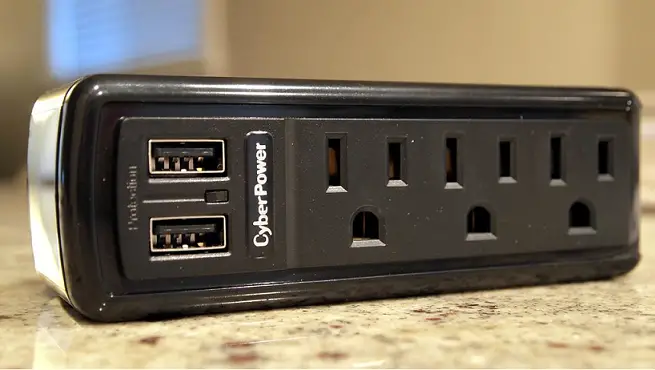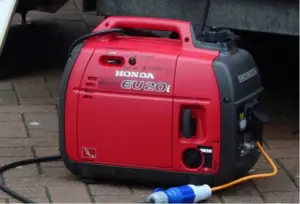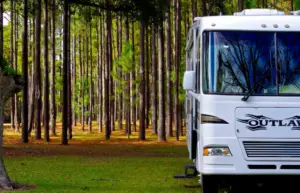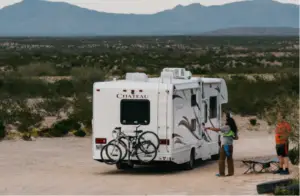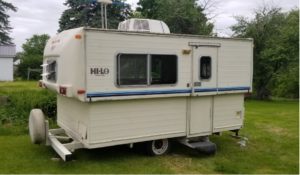You have probably heard of cases where lightning struck buildings setting them on fire. In lesser reported cases, a lightning bolt may strike a tree or a power line, leading to a surge in electrical voltage.
Though this surge may not always high enough to cause a fire, it can do irreversible damage to the plugged electrical appliances.
A surge protector is an electrical component used to cushion your electrical circuitry from the spikes in voltage. A surge protector acts like an airbag which reduces the impact on the passengers when a collision occurs.
So, here comes the big question, is your RV safe without one? Do you need a 50- or a 30-amp surge protector? Let’s find out.
Why do you need a surge protector for your RV?
The main difference between RVing and other forms of camping is the convenience of hooking up to an electrical outlet. This is the exact reason why you’d need a surge protector.
If you’ve been around several campgrounds, you probably know how strange the different outlets can be.
First, not all outlets are wired correctly. A wiring error could mean a higher risk of power surges or lower-than-standard voltage. Either way, this could damage your RV’s electrical wiring, not to mention the plugged appliances. In the worst-case scenario, the RV may catch fire.
A surge protector is a small device that protects your RV from the power surges. It acts as an interface between the external supply and your RV’s inlet. This way, your RV will not suffer from spikes from lightning or any short-circuiting in the mains.
The most common surge protectors are the plug-and-play types. They have a male and female side.
- The male side resembles your RV’s power plug, compatible with the campground outlet.
- The female side resembles the campground outlet.
You plug the surge protector into the campground outlet and then plug your RV supply cord into the protector. This way, the current and voltage supplied are maintained within a designed range.
Sometimes the surge protector may have several outlet sockets.
Do RVs come with inbuilt surge protectors?
RVs do not come with inbuilt surge protectors. This is because the RV manufacturer would not know every electrical equipment you’ll have on board at any given time. It is thus not possible to determine each buyer’s peak power demand.
As we shall see in a short while, RV surge protectors are of different types and ratings. The rating represents the maximum permissible amount of current or voltage. The more powered equipment you have running in your RV, the higher the energy load.
You need to buy your own surge protector depending on your energy demand and the campground’s available voltage. This is why these spike protectors have to be different.
Do I need a 30-amp or 50-amp surge protector?
Knowing the required rating of your RV surge protector is the most important thing to know when shopping around for one.
The most common ones are rated 30-amp and 50-amp. So, how do you choose the ideal one?
The first thing that many people do when looking for a new surge protector is search “30 amp or 50 amp?”
But what’s more important than this question? How much power do I need? What type of appliances do I have plugged into my current surge protector? All of these questions will help answer whether the 30-amp or 50-amp option is better for you.
The kind of RV you have is the primary determinant of what protector you go for. If your RV has 50-amp service, you need a 50-amp surge protector. Similarly, if your RV has 30-amp service, go for a 30-amp spike protector.
The choice between a 30-amp and 50-amp surge protector depends on a couple of factors.
If you have an RV that is older than 10 years, chances are that it only has 30-amp service. This is because, in the past, many people did not travel with their RVs very often and would use them as second homes or seasonal getaways.
Nowadays, however, more and more people are using their RVs as full-time residences, so they need to invest in more extensive power sources like 50 amp services to handle larger appliances such as air conditioners and refrigerators.
Difference between 30-amp and 50-amp campsites?
The most straightforward difference between 30 and 50-amp campsite outlets is the number of plugs. A 30-amp outlet accommodates a three-prongs plug, while a 50-amp outlet has four holes to plug into.
The 30-amp plug usually has a 120-volts hot wire, a ground wire and a neutral wire. The 30-amp will provide 120 volts, which is enough for most RVs with smaller devices such as microwaves and coffee pots.
On the other hand, a 50-amp campsite hook-up plug has four prongs. These are two 120-volts hot wires, a neutral and a ground wire. This provides up to 230 volts of power to the appliances in your RV.
Can you plug my RV interchangeably (30-amp, 50-amp)?
Yes. You can plug your RV interchangeably, but you need to understand your unique situation and how to go about it. Below is a breakdown of the most common scenarios and how to go about them:
Plugging a 30-amp surge protector into a 50-amp campsite
You can plug your 30-amp RV (with a 30-amp surge protector) into a 50-amp outlet. The surge protector won’t let more than 30 amps current, which means your RV will be protected.
For this hook-up to be possible, you’ll need a 50- to 30-amps adapter. Plug the adapter into the outlet and then the surge protector.
Plugging a 50-amp surge protector into a 30-amp campsite outlet
Just because your RV has a 50-amp service and the campground only offers 30 amps doesn’t mean you’re out of luck. You can plug RV into a 30-amp outlet. However, the RV will only draw 30 amps of current.
Still, the 50-amp surge protector will protect your RV from any spikes in the 30-amp supply.
Plugging a 30-amp surge protector into a 20/15-amp campsite
A surge protector is necessary even when plugging into lower amperage campsites, such as 20 and 15 amps. You never know when or where an electrical surge may occur.
You only need the appropriate adaptor between the supply and your surge protector.
Since your RV’s power load will most likely be higher than the supply, you should expect to flip the circuit breaker at the campsite outlet.
Plugging a 50-amp surge protector to a 20/15-amp campsite
Just like in the above case, a 50-amp protector will guard your RV against power surges and brownouts in a 20/15-amp supply line.
The limitation will be that you won’t use high-powered appliances such as air conditioners in your RV.
You still need an adapter to couple the 50-amp protector to the 20/15-amp supply.
How do you choose a surge protector?
Here comes the big question. Apart from what we have already discussed, here are a few more things to consider when choosing an RV surge protector:
Power rating in joules
Protection rating is quantified in joules. Generally, when there is a high frequency of spikes, the surge protector heats up. If the unit is not able to dissipate the heat fast enough, it poses an overheating danger. Look for a protector with a high power rating to prevent your summer trip from becoming a disaster.
Amp rating
This is the primary factor to consider. You should choose a surge protector that conforms to your RV service requirement. If you have a 50-amp motorhome, go for a 50-amp surge protector. Do similarly for a 30-amp RV.
Installation
Although most surge protectors are easy to use, not all come with clear usage instructions. Even with clear instructions, some may not be easy to install. If you intend to camp regularly, go for something you can easily install.
Weight
Camping is one of the most weight-sensitive adventures. You do not want to exceed your RV’s GVWR or bring along space-consuming gear. Go for a lightweight surge protector, one that can easily tuck away in your RV. Ensure it is compact so that it doesn’t consume your precious space.
Price
The choice of what to buy is usually dependent on budget, alongside other factors. You can find a good surge protector on budget, but you’ll have to do your homework. Most cheap products don’t perform as expected.
Light indicator
Most surge protectors have LED light indicators that show when the device is in operation. Ensure your unit has the indicators. These can also be useful during the night when most of the things outside the RV are not clearly visible.
Noise
Surge protectors produce some sound when in use. Go for a unit that is not too loud, especially on those clear nights when all you want to enjoy is a perfectly quiet night.
Wrapping it up
The surge protector is the most essential accessory you can get for your RV. It protects sensitive electronics from power spikes and surges by providing a buffer between them and an electrical outlet. There are many different types of surge protectors, so you must know what type will work best for your needs before purchasing one.
If unsure of the one to buy, read through the various aspects above to make an informed choice.

